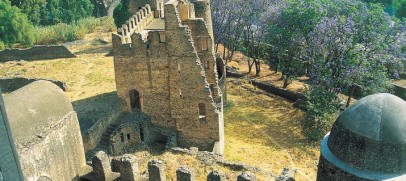Ethiopia’s Historical Highlights

1-Join tour Addis Ababa
Addis is situated at an elevation of around 2438m and is only about a century old. It has some elegant modern buildings and is quite spacious with wide streets and green areas. It remains the capital of a predominantly rural area. This afternoon we will make an orientation tour of the city visiting the two major highlights of the city, the Ethnographic Museum and the church of the Holy Trinity, whose large dome and slender pinnacles make it a landmark in the city.
Overnight: Standard Hotel
Single Room option available
2-Fly to Bahar Dar; visit Tississat Falls
Today we fly north to Bahar Dar, capital of the Amhara region situated on the shores of Lake Tana. We visit Tississat Falls, Amharic for ‘water that smokes’ located about 32km south of Bahar Dar. After crossing a 16th century Portuguese built bridge, we walk up the hillside on an easy path to a viewpoint (approximately 45 minutes). There may also be time today to visit a viewpoint close to the Nile source near a one time residence of Haile Selassie. Here we can pause to consider the tremendous distance this body of water must now travel to reach its mouth in the Delta region of lower Egypt and the Mediterranean. Please note: viewing of the falls is subject to local authorities allowing water to flow from the Blue Nile dam.
Overnight: Standard Hotel
Single Room option available
3-Boat trip on Lake Tana; drive Gondar
We spend this morning aboard a boat travelling on Lake Tana visiting some of the historical places which have been used for refuge over the centuries. These secure lush islands have protected Christian emperors and their riches during times of upheaval and invasion, and might even have played host to the Ark of the Covenant. Small well-protected churches still contain religious treasures within their sanctuaries, including crowns and chalices. We hope to include visits to Ura Kidane Mehret and Azwa Mariam on the Zeghie peninsula, dating back to medieval times and containing valuable manuscripts and vestments. This afternoon we will continue our journey by driving to Gondar.
Overnight: Standard Hotel
Single Room option available
4-In Gondar; visit Debre Berhan Selassie church and castle complex
Located on the high plateau, Gondar was once the imperial capital of Ethiopia for 200 years. Gondar’s most famous monuments are its exceptionally well preserved 17th century castles. The largest and best is that of King Fasilidas. It is a stone-built construction with round turrets and wooden balconies. The king also built a remarkable bath a mile or so outside of town known as the ‘Pavilion of Delight’. This whole complex of buildings is unique in Ethiopia and unlike anything found elsewhere in Africa. This afternoon, as well as visiting the castle ruins, we’ll also make a visit to the Debre Berhan Selassie Church famed for its ceiling frescoes of many faces.
Overnight: Standard Hotel
Single Room option available
5-Drive to Debark; walk in the Simien Mountains
A morning’s drive takes us to Debark in the Simien Mountains. The range lies north of Gondar and many of the peaks rise above 4000m, with the highest peak of Mt. Ras Dashen at 4543m being the fifth highest in Africa.The mountains are criss-crossed with tracks worn out by the local people travelling from village to village or moving their animals to fresh pastures. The combination of these tracks and the spectacular scenery make for excellent walking. We will take a short trek this afternoon to enjoy this region. There maybe time today to visit Wolleka Falasha village. The Falasha Jews are thought to have come into Ethiopia 3,000 years ago at the time of King Solomon and the Queen of Sheba, but their history is shrouded in mystery. The name Falasha means ‘exiled’ in Amharic, and they themselves claim decent from Moses – it is interesting to note that according to the Bible, Moses took an Ethiopian wife. Almost all of the Ethiopian Jews were taken to Israel during the wars and famines of the 1980s and 90s, but they have found it difficult to assimilate themselves into the modern Israeli lifestyle.
Overnight: Simple Hotel
Single Room option available
6-Drive to Axum
Although the roads are rough and dusty, the views in this remote part of Ethiopia are simply spectacular and more than make up for them. The drive affords some excellent photo opportunities of the jagged Simien Mountains and the Tekeze Valley. The route is dotted with intermittent mountain hamlets that add to the splendour of the scenery. Our journey brings us to the sacred city of Axum in the Tigrayan region, that was the capital of the Ethiopian empire between the 1st and 10th centuries AD. As the birthplace of Christianity within the country, it was also a bustling commercial centre. Please note: should the road to Axum be impassable due to local conditions, we plan to return to Gondar and fly to Axum.
Overnight: Standard Hotel
Single Room option available
7-In Axum
Evidence of Axum’s former importance now lies at several points in or near the town. Ruined fortresses, palaces and churches, plus an abundance of giant obelisks or ‘stelae’, carved from enormous slabs of granite stand as mute reminders of its former glory. Axum makes claim to be the final resting place of the sacred Ark of the Covenant. But while its local guardians continue to celebrate the legend, the object of their veneration is kept strictly under wraps.
Overnight: Standard Hotel
Single Room option available
8-Drive and visit Yeha and Adwa; continue to Adigrat
Today we head east from Axum to Yeha, said to be Ethiopia’s oldest settlement, probably dating back almost 3,000 years. A large temple, dedicated to the moon god Ilmuqah, is related to other pagan temples to the same god in Yemen, indicating connections across the Red Sea from the earliest times. The temple was later converted into a church in the 6th century, but still has wonderful friezes of ibex carved into the façade. En route we shall make a visit to the important town of Adwa, set amidst rugged mountains. It was at Adwa that the Ethiopians became the first African nation to repel a colonial power, when they defeated the Italian army in 1896. Since then, Ethiopia has been a symbol of African independence, free from European control. We will visit the Saturday market here. This afternoon we continue to the town of Adigrat.
Overnight: Simple Hotel
Single Room option available
9-Visit Tigray churches; continue to Mekele
Today we head into the Tigray region to discover the remarkable rock-cut churches. These architectural gems were created prior to the 16th century and unknown to the outside world until the 1960s. About 150 are now known to be in existence with all but a handful still in active use by the orthodox Christian community. We look to explore two clusters including Abreha. We visit Atsbeha and the sandstone church of Chirkos at Wukro with its cruciform pillars and barrel vaulted ceiling. We will also make a visit to the Negash Mosque and tombs which is the most importatnt Islamic site in Ethiopia and the oldest mosque outside Arabia!
Overnight: Standard Hotel
Single Room option available
10-Drive to Lalibela
A full day drive today takes us to the south, between the mountains to the west and the start landscape of the Danakil Depression to the east, via the town of Woldiya, to arrive at the remarkable archaeological site of Laliblea.
Overnight: Standard Hotel
Single Room option available
11-In Lalibela; visit rock cut churches
We spend today exploring one of the world’s most remarkable historic sites. Although churches carved in rock are found in other parts of the world, those found in Ethiopia are particularly interesting. Generally, they were excavated on all sides of a rectangle, leaving a large block of stone isolated in the centre. This rock was then shaped and formed both inside and out and the carvings show extremely skillful workmanship. Lalibela, the ‘New Jerusalem’, is thought to have been constructed some 800 years ago by King Lalibela. Lalibela was his capital city, but today it is a small village, virtually cut off from the outside world. Our tour this afternoon involves a certain amount of scrambling through a labyrinth of tunnels. The churches stand in two main groups on either side of a stream, known locally as ‘The River Jordan’. There are 11 rock-cut churches of which the most impressive is Bet Giorgis. It is carved in the form of a Greek cross and approached through a passage in the rock. Between them, these rock-cut churches are one of the great wonders of the world. Most churches have a permanent roof built over them to preserve them and are listed as a UNESCO World Heritage site.
Overnight: Standard Hotel
Single Room option available
12-In Lalibela; mule trek
Mountains encircle Lalibela and located among these peaks are several more isolated churches. Using mules, we journey for some two hours to Ashatan Maryam church and are rewarded with stunning views over Lalibela and the peaks and mountains of these remote highlands. Reached by steep paths, it will be necessary to dismount in places due to the shaley path. Alternatively you may wish to walk instead of riding the mules. Good footwear is a must! Vertigo sufferers or people with a low level of fitness may choose not to partake in the mule trek, your tour leader can advise you. In the afternoon, we return to Lalibela allowing more time to explore the rock-cut churches.
Overnight: Standard Hotel
Single Room option available
13-Fly Addis Ababa. Tour ends.
We aim to arrive early in the afternoon where the tour ends.
Tour includes:
12 Breakfast
Transport:
Bus, Boat, Flight
Accommodation:
10 nights Standard Hotel
2 nights Simple Hotel
Tour Staff:
Local Guide(s), Boat Crew, Muleteer(s), Guest Lecturer
Group Size:
Generally 10 – 16
![]() Explore have been running small group adventure holidays throughout the world since 1981 and have a vast array of experience, knowledge and well established close personal contacts in all the countries in which they operate, which makes them stand out as one of the most trusted adventure tour operators in the UK.
Explore have been running small group adventure holidays throughout the world since 1981 and have a vast array of experience, knowledge and well established close personal contacts in all the countries in which they operate, which makes them stand out as one of the most trusted adventure tour operators in the UK.
They are passionate about what they do, and above all, simply love nothing more than to travel. The founder directors ran overland trips through Asia, Africa and the Americas in the 1960s and 70s prior to setting up the company, and were determined that the spirit of adventure that was such an important part of those early pioneering days, should continue to play key role as part of the driving ethos of Explore.
Our Opinion
It is little wonder that over 60% of all Explore customers who travel each year have travelled with them previously, Explore are clearly committed to the “travel experience” and their itineraries are always offer that slight “Explore Twist” which makes them even more appealing.

